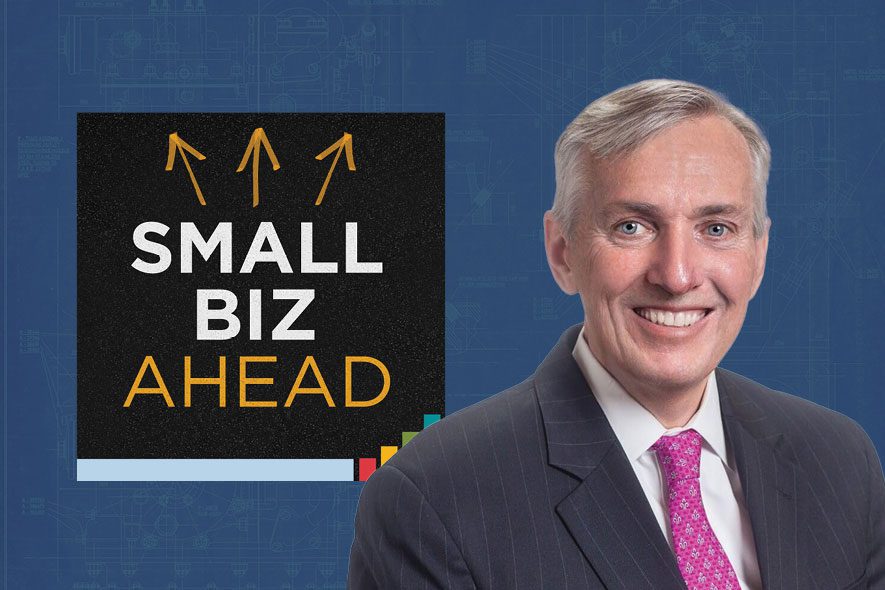Transcript
The views and opinions expressed on this podcast are for informational purposes only, and solely those of the podcast participants, contributors, and guests, and do not constitute an endorsement by or necessarily represent the views of The Hartford or its affiliates.
You’re listening to the Small Biz Ahead podcast, brought to you by The Hartford.
Our Sponsor
This podcast is brought to you by The Hartford. When the unexpected strikes, The Hartford strikes back for over 1 million small business customers with property, liability, and workers compensation insurance. Check out The Hartford’s small business insurance at TheHartford.com.
Gene (00:02):
Hey everybody, it’s Gene Marks and welcome to this week’s edition of the Hartford Small Biz Ahead Podcast. This week, I would like to give some thoughts to help you with forecasting. Now, a lot of times I have clients that kind of shy away from forecasting cause it’s tough to see what’s happening in the future. But I have to assure you, if you’re listening to this, we’re here in, getting into mid 2023. It is a slowing economy. There are a lot of pressures on a lot of businesses. There’s slowing demand. I’m sure you’re seeing this. And it is now more than ever, absolutely critical that you do your best to look into the future. To forecast what your cash is going to be. I have learned this from my smartest clients who have put together a forecast that they use all the time.
Gene (00:55):
Now listen, I don’t need you to have a crystal ball and tell me what your business is gonna be like over the next year. I get it. That’s a long period of time. But I want to ask you this question. Do you know what your cash is gonna be 90 days from now? Just 90 days. Can you tell me in three months what your cash balance is gonna be? If you can’t tell me that, then you need to do a cash forecast. My best clients do this, and they know and it helps them operate their business. Now you say to me, “Hey, it’s tough to forecast. I don’t know enough about it. I’m not an accountant, I’m not a financial person.” Let me walk you through how to put together a very simple 90 day forecast of your cash that will have a huge impact on your life.
Gene (01:42):
You ready? Step one. You need to figure out what your overhead is gonna be over the next 90 days. And you know what? You know what it is, don’t you? You know what your payroll is. You know what you’re paying in rent or debt payments, car payments, internet. You know what your sort of, most of your overhead is going to be, at least over the next 90 days. You know this right now, I know this when I look at my books. So you can forecast out what your overhead is. That’s really easy. Next, I need you to tell me what your margins are for the products and services that you sell. Now, you might have different products and services. I get that. And your margins are certainly not an exact science. This is not in the science, by the way…
Gene (02:25):
This is art. So estimate, you tell me. When you sell a product or a service, what’s the general margin? What is your sales revenue minus your direct costs of that product or service when you’re selling it? So if you’re in the service business, maybe you’re reselling service employees that are out there doing work on an hourly basis. Well, you know what their cost is per hour. And then you can figure out what your margin is, based on that. So for every dollar that you sell, every dollar of revenue, you should have a margin related to it. You know this. And listen, again, it can be an estimate. So maybe your margin is 20%, 30%, 40%, that’d be great if it was 40%. Generally on most products and services, margins have been around 30%. But they might differ for your business.
Gene (03:16):
And again, I know you might have different product lines, but you can come up with an estimated margin. So we did step one. We figured out our overhead for the next 90 days. And step two, we came up with an estimated margin. It’s 30%, say of all of our revenues. Here’s step three and this is a hard one. Figuring out what your revenues are actually gonna be over the next 90 days. You say to me, I don’t know. I mean, it’s something in the future, but you know what you? You probably do know because you’ve got a lot of different sources that you can use to piece this together. And you can do this pretty regularly. Like for example, you know what your open orders are or your backlog, right? Or your open projects that you haven’t built yet. Maybe you’ve got a pipeline report in your CRM, your customer relationship management system.
Gene (04:04):
So you know what potential things are coming in that you might be billing out and collecting in the next 90 days. Or you could talk to your salespeople and ask them what they plan on closing in the next 90 days that will turn into cash in the next 90 days. And finally, you can also look back into history. Assuming you were in business before the pandemic, you can look at the same 90 day period from 2019, 2018, 2017. I am betting, if you put together all of those factors, you can come up with an estimate of cash revenues over the next 90 days. So there you’ve got your cash revenues, you’ve figured out your estimated margin. You then take away from it your overhead over the next 90 days. You’re almost there. The last thing I want you to do is just take a step back and think about if anything unusual is gonna happen in the next 90 days.
Gene (04:54):
Maybe a big estimated tax payment or a big balloon payment on your debt or a supplier payment, something unusual. You can add that in as well. And boom, you’ve got your forecast done. You can take your cash balance at the beginning of this month and then you can take the net number from your revenues, less margins, less your overhead, less any extraordinary items to come up with what your net cash will be during those 90 days. Add it to your or subtract it from your existing cash. And you are gonna have a pretty good idea of what your cash balance is gonna be 90 days from now. And here’s the thing, if you do this or you have somebody in your company do this, every month at the end of the month, it’s just your routine. It’ll get easier and easier and easier. And suddenly you will know the future.
Gene (05:46):
Because my best clients are always looking ahead. They’re always thinking what’s coming down the pipe. Their mind isn’t necessarily on today. It’s on three months from now, three years from now in some cases. You’ve gotta be doing the same thing. So do a cash flow forecast. You can do it on the back of an envelope, you can do it on a spreadsheet. It does not have to be super complicated. You don’t have to do it for the next 12 months, because that’s pretty tough to do. I’m just asking 90 days. Can you tell me what your cash is gonna be 90 days from now? I’m telling you, if you put together a good process to do a forecast, you will be able to do that. And guys, it will change your life. You will no longer be operating your business in the dark. You’ll be seeing the direction that things are going and if it’s exceptionally good or bad, you can make specific decisions and take actions to adjust in advance before something hits you blindsided. So do a cash forecast, please. That’s my advice to you this week. You’ve been listening to Gene Marks and this is the Hartford Small Biz Ahead podcast. If you need other tips or advice or help in running your business, please visit us at SmallBizAhead.com or SBA.TheHartford.com. Again, my name is Gene Marks. Thanks for listening. We will see you again next week with some other piece of advice I have to help you run your business. Take care.
Download Our Free eBooks
- Ultimate Guide to Business Credit Cards: The Small Business Owner’s Handbook
- How to Keep Customers Coming Back for More—Customer Retention Strategies
- How to Safeguard Your Small Business From Data Breaches
- 21 Days to Be a More Productive Small Business Owner
- Opportunity Knocks: How to Find—and Pursue—a Business Idea That’s Right for You
- 99 New Small Business Ideas





